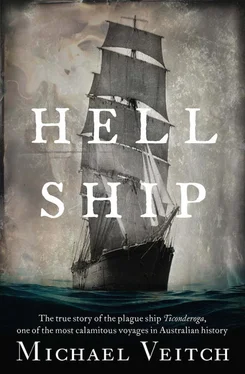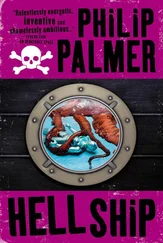Indeed, genuine bonds and friendships—even romances—did form on the journey, to eventually form part of the emigrants’ new life in Australia. There are at least two recorded cases of marriage between passengers, even though one of those—between a Cameron and a McRae—occurred much later in their lives, as the two were only young children at the time of the journey.
Much of the bonding between passengers inevitably occurred at mealtimes. Twice a day, in an exercise of mutual cooperation, the provisions for each meal were carefully doled out from the ship’s stores by the stewards and the ship’s third mate, who between them decided the daily menu, which in fact varied hardly at all. The ingredients were taken to the desk in a baking dish or lidded pot, where the ‘mess captain’—elected by the members of the mess but rotated somewhat—was responsible for bringing them to the galley to be prepared by the ship’s cooks as well as the passengers themselves. A chit would be received and, when ready, the cooks bawled out the number, and the meal was collected and then doled out to the mess on the tin plates and cups each person had been issued, and for which they were responsible.
The ‘menu’ varied only slightly from day to day and can hardly be described as exciting, or even particularly nutritious in the modern sense, but given the restrictions of the era prior to the advent of refrigeration, it was at least sustaining. Most main meals, taken in sittings from mid-afternoon, consisted of salted pork or beef (which would be all but inedible to a contemporary palate), supplemented by a pudding of suet (animal fat), flour and raisins. Other meat was dried and reconstituted into a sort of stew, as were some other starchy foods such as rice and potatoes.
Sailing to Melbourne from England at exactly the same time as the Ticonderoga in a smaller vessel, the Emily , Frenchman Antoine Fauchery, who would later set up a world-famous photographic studio in Melbourne, remembered the monotony of the shipboard meals somewhat sardonically:
Each week our provisions allow us, and more than allow us, to have three or four meals a day if we see fit. In the morning, salted beef with dried potatoes; at noon, salt pork with rice; at two o’clock, dried potatoes with salted beef; at four, rice with salt pork. –Lord bless you, if we wanted it, we could at eight o’clock have both salted beef with potatoes and salt pork with rice! [10] Charlwood, 1981, p. 201
There were no fresh vegetables and, being a government-assisted ship, the luxury of live animals carried for fresh meat was not forthcoming. Even a henhouse for fresh eggs—a not uncommon practice for ships of the time—seems to have been absent from the Ticonderoga ’s inventory of provisions. Unlike on private-paying vessels, alcohol—except for medicinal purposes—was prohibited, with any liquor in a passenger’s personal possession having to be surrendered upon coming aboard. The lack of fresh potatoes in particular was found by many of the Scots, as well as the handful of Irish, to be particularly irksome, forming as they did the starchy, bulky staple of their diet. In a later British parliamentary inquiry into many aspects of the ‘double deck’ voyages to Victoria, the difficulty of some passengers in coping with the lack of potatoes was specifically addressed:
The potato has a small quantity of nutritive matter in a large bulk, and consequently extends the stomach largely; and those who have been accustomed to it, when they are put on a more nutritive and concentrated food, felt a sensation of sinking and emptiness. They attempt to remedy that by taking a larger quantity of food, which they cannot digest, and that immediately produces disease (sickness and diarrhoea). [11] British Parliamentary Papers, Papers Relative to Emigration to the Australian Colonies, First Report from the Select Committee on Emigrant Ships with Minutes of Evidence, Explanation of deck plans by Kenneth N. Sutherland R.N., House of Commons, Sessional Papers 1852/53 vol. LXVIII
The greatest fault in the Ticonderoga ’s meal system, however, was the complete lack of provision of food for the many infants, who were expected to be sustained solely by their breastfeeding mothers. This would have dire consequences throughout the voyage, not only with some babies wasting away due to the effects of malnourishment—or marasmus, as it was called—but also later, when many of the adults could barely sustain themselves.
After the meals, the routines established in the depot were resumed, with the women clearing and cleaning the utensils and the men sweeping the decks and dry hollow-stoning the desks. No fresh water was permitted for washing of any kind, so plates and eating utensils were covered with a permanent film of salt. Clothes, too, could only be washed on specified days in seawater tubs on the upper deck, unless supplemented by rainwater occasionally captured in specially erected awnings. Marine soap, made from palm or coconut oil and soluble in seawater, was issued; although today it would be barely recognisable as soap of any description, it was for many of the Ticonderoga ’s passengers their first experience of it, due to it being heavily taxed as a luxury item. The daily discomfort of living for weeks in such clothes—itchy and salt-encrusted—is another aspect of conditions of the voyage that modern sensibilities would struggle to comprehend.
The single men in particular were kept busy on the ship, being allotted an array of tasks such as pumping seawater up to the flushing tanks above the water closet, sweeping decks and ladders daily, and keeping the ship’s hospitals in good order. Several times a week, those rostered would venture through the lower decks, sprinkling and scraping away absorbent hot sand on the walkways and under the passengers’ bunks. The young women, however, were required to clean out their own quarters.
Some men were even permitted to assist the crew in the running of the ship. This was a task many came to relish, eager to be introduced to the complex world of sail, delighting in the learning of nautical terms and the names given to the myriad knots, spars and sails: topgallants, royals, spankers and so on. What the ship’s crew made of having to teach such a group of novices can only be guessed at and, inexperienced as they were, the danger of accidents was real. On the voyage of the Hornet from Southampton to Victoria in 1857, a male passenger had his hand crushed in a block while helping the crew to pull ropes. The ship’s surgeon, a Dr Brownfield, was required to amputate two fingers and sew the skin back over the stumps, his patient’s only relief from the pain being a large dose of brandy administered from the surgeon’s medicine chest. [12] Haines, 2003, p. 190
At least at the beginning of the voyage, and if not riddled with seasickness or weighed down with children, for some the romance of the journey was still novel, and provided the passengers with experiences utterly removed from their lives hitherto and that they would remember forever. Despite the lessons, routines and other activities, there were many hours of free time on board the ship, which were theirs to pass as they pleased: long conversations with people with whom they would never otherwise have crossed paths; watching the undreamed-of sights of dolphins, porpoises, flying fish and the myriad seabirds following the slow pace of the ship. Then there was the ever-changing texture of sea and sky. On some afternoons and evenings, the sounds of fiddles and pipes resonated throughout the ship as the Scots lasses instructed some of the other girls in the art of Highland dancing. At other times, the girls would sing the plangent tunes of their home, which would quickly be picked up by the rest of the passengers, transforming the ship into a floating and melancholy chorus.
Читать дальше












